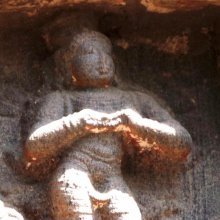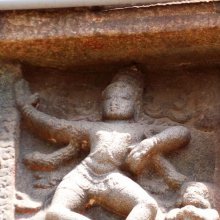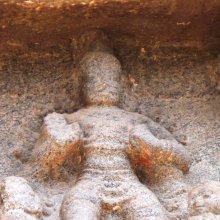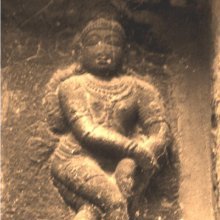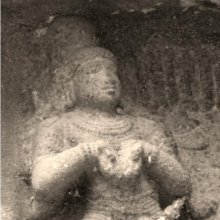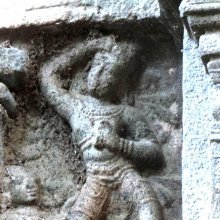Parivartita: 7 definitions
Introduction:
Parivartita means something in Buddhism, Pali, Hinduism, Sanskrit. If you want to know the exact meaning, history, etymology or English translation of this term then check out the descriptions on this page. Add your comment or reference to a book if you want to contribute to this summary article.
Images (photo gallery)
(+1 more images available)
In Hinduism
Natyashastra (theatrics and dramaturgy)
Source: Wisdom Library: Nāṭya-śāstraParivartita (परिवर्तित) refers to one of the four classes of hastakaraṇas, or “movements of the wrist and hand”, according to the Nāṭyaśāstra chapter 9. The hands form a part of the human body which represents one of the six major limbs (aṅga) used in dramatic performance. With these limbs are made the various gestures (āṅgika), which form a part of the histrionic representation (abhinaya).
Source: archive.org: The mirror of gesture (abhinaya-darpana)One of the four Necks: Parivartita: moving to right and left, like a half-moon. Usage: Sṛṅgara-naṭana (erotic dances), when kissing the cheeks.

Natyashastra (नाट्यशास्त्र, nāṭyaśāstra) refers to both the ancient Indian tradition (shastra) of performing arts, (natya—theatrics, drama, dance, music), as well as the name of a Sanskrit work dealing with these subjects. It also teaches the rules for composing Dramatic plays (nataka), construction and performance of Theater, and Poetic works (kavya).
In Buddhism
Mahayana (major branch of Buddhism)
Source: De Gruyter: A Buddhist Ritual Manual on AgricultureParivartita (परिवर्तित) refers to “coiled” (e.g., ‘depicting a coiled snake’), according to the Vajratuṇḍasamayakalparāja, an ancient Buddhist ritual manual on agriculture from the 5th-century (or earlier), containing various instructions for the Sangha to provide agriculture-related services to laypeople including rain-making, weather control and crop protection.—Accordingly, [as the Bhagavān teaches the offering of the root spell], “[...] Having taken brownish cow dung that has not touched the ground and taking ghee, milk and cow urine, one should mix it with seven seeds and flour. Having enchanted it ninety times with that mantra, a five-headed Nāga should be made. It should be hooded with jewels, seated cross-legged, coiled (parivartita), and having smeared it with white sandal and saffron, it should be placed on a pure seat. [...]”.

Mahayana (महायान, mahāyāna) is a major branch of Buddhism focusing on the path of a Bodhisattva (spiritual aspirants/ enlightened beings). Extant literature is vast and primarely composed in the Sanskrit language. There are many sūtras of which some of the earliest are the various Prajñāpāramitā sūtras.
Languages of India and abroad
Sanskrit dictionary
Source: DDSA: The practical Sanskrit-English dictionaryParivartita (परिवर्तित).—a.
1) Revolved.
2) Exchanged.
3) Inverted.
4) Returned, retreated.
5) Put aside, removed, destroyed; Mk.
6) Searched thoroughly.
-tam the action of turning; Bhāg.
Source: Cologne Digital Sanskrit Dictionaries: Monier-Williams Sanskrit-English Dictionary1) Parivartita (परिवर्तित):—[=pari-vartita] [from pari-vṛt] mfn. ([from] [Causal]) turned round, revolved etc., [Mahābhārata; Kāvya literature] etc.
2) [v.s. ...] exchanged, bartered, [Harivaṃśa; Varāha-mihira; Kathāsaritsāgara]
3) [v.s. ...] put aside, removed, destroyed, [Mṛcchakaṭikā; Mārkaṇḍeya-purāṇa]
4) [v.s. ...] searched thoroughly, [Rāmāyaṇa]
5) [v.s. ...] taken or put on in a wrong direction, [Horace H. Wilson]
6) [v.s. ...] n. the action of turning or wallowing, [Bhāgavata-purāṇa]
7) [v.s. ...] the place where anybody has wallowed on the earth, [Rāmāyaṇa]
Source: DDSA: Paia-sadda-mahannavo; a comprehensive Prakrit Hindi dictionary (S)Parivartita (परिवर्तित) in the Sanskrit language is related to the Prakrit words: Pariaṭṭiya, Pariattia.
Sanskrit, also spelled संस्कृतम् (saṃskṛtam), is an ancient language of India commonly seen as the grandmother of the Indo-European language family (even English!). Closely allied with Prakrit and Pali, Sanskrit is more exhaustive in both grammar and terms and has the most extensive collection of literature in the world, greatly surpassing its sister-languages Greek and Latin.
Kannada-English dictionary
Source: Alar: Kannada-English corpusParivartita (ಪರಿವರ್ತಿತ):—[adjective] changed; that has become different; undergone mutation; transformed.
--- OR ---
Parivartita (ಪರಿವರ್ತಿತ):—
1) [noun] that which is changed, transformed or has undergone mutation.
2) [noun] (dance.) a moving the shank backward.
3) [noun] (dance.) a raising the elbows to chest level, holding the arms away, bringing them before the chest and turning the palms upward with fingers stretched.
Kannada is a Dravidian language (as opposed to the Indo-European language family) mainly spoken in the southwestern region of India.
See also (Relevant definitions)
Partial matches: Vartita, Pari.
Starts with: Parivartita-kirana.
Ends with: Aparivartita, Parshvaparivartita, Utparivartita, Viparivartita.
Full-text: Parshvaparivartita, Griva, Pariattia, Pariattiya, Viparivartita, Viparivartitadhara, Nalinipadmakosha, Valitoru, Vartita, Hastakarana, Sveccha, Ancita, Vasas.
Relevant text
Search found 4 books and stories containing Parivartita, Pari-vartita; (plurals include: Parivartitas, vartitas). You can also click to the full overview containing English textual excerpts. Below are direct links for the most relevant articles:
Abhinaya-darpana (English) (by Ananda Coomaraswamy)
Bhakti-rasamrta-sindhu (by Śrīla Rūpa Gosvāmī)
Verse 2.4.109 < [Part 4 - Transient Ecstatic Disturbances (vyābhicāri-bhāva)]
Natyashastra (English) (by Bharata-muni)
Chapter IX - Gestures of Major Limbs (aṅga)
Chapter IV - Description of the Class Dance (tāṇḍava)
Gati in Theory and Practice (by Dr. Sujatha Mohan)
Elements of Āṅgika-abhinaya in Nāṭyaśāstra < [Chapter 1 - Nāṭya]
